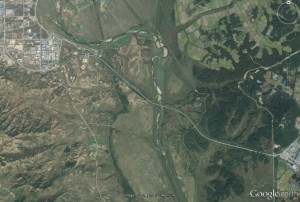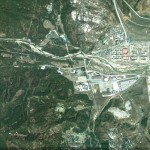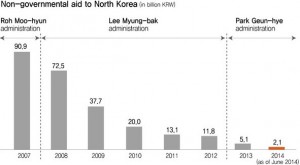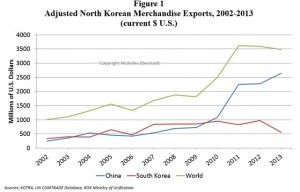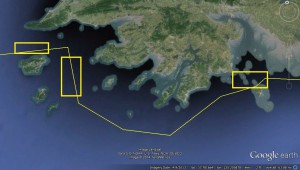UPDATE 2 (2014-10-9): AEI’s Nick Ebestasdt offers analysis on the delegation visit:
Once again the Democratic People’s Republic of Korea (aka DPRK or North Korea) is back in the news—and this time it did not secure global headlines by testing a nuclear device, or shooting rockets near its neighbors, or threatening to turn Seoul/Tokyo/Washington/etc. into a sea of fire.
Instead the world’s only ever Communist-dictatorship-cum-hereditary-Asian-dynasty has piqued international curiosity through the conjuncture of a carefully staged diplomatic event and a potentially important domestic non-event.
The event was the surprise visit by an 11 person North Korean delegation to the South—ostensibly to attend the 2014 Asian Games in Incheon, but in reality to propose a resumption of inter-Korean dialogue, which has been in a deep freeze since the 2013 inauguration of President Park Guen Hye.
The non-event is the disappearance from public view of North Korea’s “Dear Respected Leader” Kim Jong Un. At this writing, Dear Respected was last seen in public on September 3—over a month ago. Although North Korean footage of Dear Respected is always carefully doctored, he was last seen walking with a limp. He was a no-show for the Supreme People’s Assembly on September 25, a ceremony whose pageantry he would ordinarily be expected to figure in, if not center around. North Korean authorities, a group not known for indulging in glasnost, have offered no official explanation for this prolonged public absence. The most the officialdom has had to say so far is that Kim Jong Un is “suffering from discomfort,” as state television put it last week.
Unsurprisingly, both Western media and those who call themselves “North Korea experts” have been in an economy-class dither over these two developments, speculating about what each of them might mean—and also trying to fabricate a link between them. By one rumor, Dear Respected has gotten so fat that he has broken both his ankles falling off his fancy elevated shoes. No, says another whisper—he is gravely ill and his sister is in charge. Wrong again, insists a third—there has been a coup, and he has been deposed by the military. That is why the North Koreans have sent all these military types to Seoul for talks!
Having followed North Korean affairs for over thirty years myself, I have to confess that there is nothing new about the current jumble of conflicting and sometimes outlandish guesses that passes as commentary on North Korean current events. Given the DPRK government’s ruthless control and manipulation of information—two of the few things Pyongyang can actually do well—outsiders are often left more or less divining signs from chicken entrails. Add to the mix the South Korean intelligence community’s unhealthy but longstanding history of attempting to play the local and global press in accordance with its own short term agenda, and one can see how easy it is for unseasoned reporters, or even more inveterate “North Korea hands,” to get caught up in a hologram of lies.
Early on in my own research, I realized that one had to approach the North Korean puzzle as if one were in a Miss Marple murder mystery, that is to say, by proceeding under the assumption that everyone is a liar and has their own reason for misrepresenting the truth. If one starts with that premise, and takes William of Ockham as one’s guiding star, you have a chance of figuring out what is going on—but only a chance.
With this in mind, let’s start by trying to make sense of Dear Respected’s continuing absence from the propaganda stage. Is this the first time he has gone missing from action in this fashion? No. In his brief reign—since the Dear Leader’s passing in late 2011—he has been secluded from his adoring local fans at least twice before. Moreover, both his father and his grandfather made it a habit of disappearing from public view, too. Of course, rumors would fly: Kim Il Sung is dying of cancer from the big wen on the back of his neck; Kim Jong Il has died in a car crash; no, Kim Jong Il has fallen off a horse and is now a zombie. Such speculation—or should we say, wishful thinking?—always proved to be wrong. Each and every time, the Supreme Leader has come back on camera. We outsiders must recognize the obvious truth that we know so little about the dynamics of North Korean rule that we cannot even explain ex post facto why these various and repeated Kim eclipses took place. Of course, there is always a first time. This time, Dear Respected’s public hiatus may be different. But this would be a first.
And what about the North Korean delegation’s surprise visit? To begin, the North always tries to do things by surprise—that is how Pyongyang keeps control of the show. (It’s no surprise that the South Korean side would do anything they could to accommodate a North Korean official delegation—any open democracy would likewise do whatever it could to accommodate the possibility of dialogue with an implacably hostile neighbor.)The North Korean delegation certainly came south to do something more than admire the sports show—but the notion that they were coming to announce a change of regime, as some have suggested, is silly season at its silliest.
Many writers have noted the heavy military and security complexion of the visiting team, which reportedly includes the number two man in the DPRK military, the former head of the North Korean People’s army, and a fellow who might be the spy chief of the police state. Military plot? Hardly. In a state like the DPRK, most of the important jobs perforce are military, security, and intelligence. And note, inter alia, that all of these heavyweights are members of the DPRK Workers’ Party Central Committee. They’re Party boys, though not in the sense we use in Western universities. Like all other Marxist-Leninist states, North Korea’s political Party keeps the military on a tight choke chain: no one in command wants to see their regime overturned by an Asian variant of Julius Caesar or Napoleon Bonaparte. Highly decorated as they may be, these men are errand boys sent south to do their masters’ bidding.
And just what might that bidding be? If William of Ockham were wielding his famous Razor, the parsimonious surmise might whittle our guesses down to be: money. As we know from other sources, the North Korean state has become desperately dependent on the largesse of just one power: China. As we know from other sources, North Korea has never in its entire history been as desperately dependent on the largesse of a single benefactor as it is on China today. Since North Korea is perennially in need of external support, diversifying those sources of subvention is now a state imperative. To judge from early reportage, the visiting North Korean fundraising show has not done so badly on its southern tour: according to news accounts, Seoul has already been talking about easing economic sanctions, and even possibly resuming the lucrative tours to the North that were shut down after that unfortunate deadly shooting of a South Korean visitor by a guard on a beach.
The DPRK delegation may of course have more in mind than just money—South Korea has so much more to give, including its territory and its very sovereignty! But as a first guess, extracting money for the mothership may not be such a bad one.
Long ago, a memorable South Korean booklet described North Korea as “the land that never changes.” Appealing as that title may be, it is highly misleading. North Korea is constantly—in fact, almost incessantly—in flux. It has buried two Supreme Leaders, and may be working on a third. It has experienced the first-ever mass famine in any urbanized literate society during peacetime. It has achieved the most epic long-term economic fail of any standing state in the modern era. It is the first country with a Sahelian-style international trade performance profile to test nuclear weapons. And just last December, with great fanfare, it publicly announced its first-ever execution of an inner member of the royal family.
Things are always changing in North Korea. It is instead our inability to understand this country that seems to be the unchanging factor in the equation.
UPDATE 1 (2014-10-6): Following the buzz of speculation around the DPRK delegation visit to the ROK, ships exchange warning shots. According to the BBC:
North and South Korean ships exchanged warning shots after a North Korean patrol boat crossed a disputed maritime border, say officials from the south.
The incident happened around 10:00 local time (03:00 BST) on Tuesday, said South Korea’s Yonhap news agency.
It comes three days after North Korean officials agreed to resume high-level talks with the South.
Here is coverage in the JoongAng Ilbo.
Original Post (2014-10-3): According to Reuters:
Three senior North Korean officials will make a rare visit to South Korea on Saturday to attend the Asian Games closing ceremony in what could potentially bring a breakthrough in tense ties between the rival Koreas.
Heading the delegation will be Hwang Pyong So and Choe Ryong Hae, who are senior aides to North Korea’s supreme leader Kim Jong Un, South Korea’s Unification Ministry spokesman told a news briefing.
The announcement of the visit comes as a surprise because Pyongyang has been issuing invectives toward the South and President Park Geun-hye, criticising her calls for Pyongyang to end its arms programme and improve human rights conditions.
…
Hwang is the head of the North Korean army’s General Political Department, a powerful apparatus loyal to the secretive country’s leader and a key post overseeing the 1.2-million-member military.
Here is coverage in the Associated Press.
Here is coverage in Yonhap.
Here is coverage in the New York Times.
Here is coverage in the Korea Times.
Here is coverage in the Washington Post.
Here is Aidan Foster Carter in NK News.
Interesting analysis on the story in the Daily NK which provides a rational for the visit based on domestic politics.
Here is coverage in The Diplomat.
Additional Information
1. NK Leadership Watch has bios of the men: Hwang Pyong So, Choe Ryong Hae, Kim Yang Gon
2. Here are bios on Wikipedia: Hwang Pyong So, Choe Ryong hae, Kim Yang Gon
3. Here is the South Korean MOU leadership organization chart where you can see these individual’s positions within the system.
4. Andray Abrahamian writing in 38 North last year on sports.
